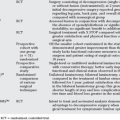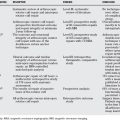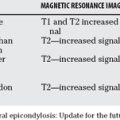Chapter 83 Total Hip Replacement: Hybrid versus Uncemented: Which Is Better?
Total hip replacement (THR) is one of the most common procedures performed in orthopedic surgery. With an ever-aging population and increasing levels of obesity, arthritic joints are becoming more prevalent. Furthermore, arthroplasty is being performed in younger and younger patients. Although THR results in substantial improvement in quality of life, it is not without intraoperative and postoperative risks, including fat embolism, deep venous thrombosis (DVT), pulmonary embolism, and ultimately failed prosthesis, necessitating another, more significant revision surgery. This chapter examines the decision to cement the femoral component.
The first issue is the risk of intraoperative fat emboli. Fat emboli presents a potential intraoperative adverse event, including the rare but critical bone cement implantation syndrome (BCIS), which leads to death in 0.6% to 1% of patients.1 BCIS is characterized by hypoxemia, hypotension, cardiac arrhythmias, and cardiac arrest in any or all combinations. Transesophageal echocardiography (TEE) has been used in many studies to evaluate the size and magnitude of embolic cascade during the reaming of the femoral canal. Here, we compare different techniques in hip arthroplasty and show examples of measures taken to reduce the risk for complications from fat emboli in cemented and uncemented arthroplasty.
In one study, the incidence of bone marrow and fat emboli among cemented and uncemented THR was similar2 (Level of Evidence II). Here, 50 consecutive bilateral hip replacements and 106 unilateral hip replacements were enrolled in this study, for a total of 206 hip arthroplasties. One hundred of the hips were treated with cemented stems, whereas 106 of the hips were replaced with uncemented stems. Arterial and right atrial blood samples were obtained before implantation, at 1-, 3-, 4-, and 10-minute intervals after implantation, and at 24 and 48 hours after the surgery. This study found no difference between the prevalence of fat embolism in cemented and uncemented stems, regardless of patients receiving bilateral or unilateral arthroplasties.
Christie and colleagues3 found that cemented compared with uncemented hemiarthroplasty in the treatment of femoral neck fractures caused greater and more prolonged embolic cascades (Level II). A subsequent study evaluated minimal versus thorough lavage of the femoral canal and found a statistically significant reduction in duration of the embolic responses and number of large emboli, together with less pulmonary function disturbance4 (Level II). Although these studies were not done in the context of hip arthroplasty for arthritic joints, it speaks to the importance of thorough femoral canal lavage before cementation.
A modified cementing technique using vacuum drainage into the proximal femur has been successful in reducing intramedullary pressure and the incidence of embolism5 (Level II). Koessler and coworkers5 studied the effects of placing vacuum drainage in the proximal femur to reduce the increase in intramedullary pressure during prosthesis insertion. To perform this study, 2 groups of 120 patients were randomized. One group received a total hip arthroplasty using a conventional cementing technique, and the other group used the modified technique described earlier. Perioperative monitoring of embolic events was done by continuous TEE, hemodynamic monitoring, and blood gas analysis. The results in this study show that 93.3% of patients receiving the conventional cementation experienced embolism contrasted with 13.3% occurrence rate in patients undergoing total hip arthroplasty using the modified technique (P < 0.05). Intraoperative shunt values increased from 8.2% to 10.3% during femoral component insertion in the conventional cementation group (P < 0.05). No significant changes were found during femoral stem insertion in the modified group. No patients in either group sustained fat embolism syndrome. These results show that the embolic events seen under TEE can lead to increased pulmonary shunt values during THR, most notably in those patients with systemic disease. The modified technique, designed to reduce increases in intramedullary pressure, reduced the incidence of embolism.
Pitto and investigators6 performed a similar study, utilizing a bone-vacuum technique in the experimental group (Level II). Here, 130 patients were randomized to receive a standard cemented hip without the use of a bone vacuum or to have the arthroplasty performed with the use of a bone vacuum (65 patients in each study). This study examined the incidence of embolic events via TEE as well. However, serial duplex ultrasonography was used to assess the occurrence of DVT in each of the groups. This was done the day before surgery and on postoperative days 4, 14, and 45. The control, standard cementation group had significantly more embolic particles and masses (in 59 patients, or 91%) versus the group that underwent femoral component implantation with the concurrent use of a bone vacuum (10 patients, or 15%). Furthermore, ultrasonography on postoperative day 4 found DVT in 12 of the patients in the control group (18%) compared with a DVT rate of 3% (2 patients) on postoperative day 4 in the experimental group (P < 0.05).
Pitto and investigators7 also examined the incidence of fat embolism in uncemented versus cemented hip arthroplasty in the following study. To assess this, they randomized 60 patients to 1 of 3 groups of 20 patients each. Group 1 received uncemented femoral stems, group 2 received femoral stems with conventional cementation, and group 3 stems with modified cementation technique. Again, TEE, hemodynamic, and blood-gas analyses were performed intraoperatively to assess for embolic events. Severe embolic events, defined as a cascade of fine echogenic particles less than 5 mm in diameter, were observed in 17 of 20 patients in group 2 (85%). Group 1, the uncemented group, has no patients with this occurrence. Group 3, with stems implanted using modified cementation technique, had one patient with severe embolic events (5%)7 (Level II). Group 1 had an average increase in intrapulmonary shunt values of 24% (P < 0.05), whereas the other two groups did not have a significant change detected. Thus, this study showed it is imperative to consider the overall health of the patient with THR in preoperative planning, most notably in their ability to cope with embolic events or intraoperative pulmonary impairment if a conventional cementation is to be performed. This is less of an issue if bone-vacuum cementation is performed or an uncemented stem is implanted. This study shows that the defined severe embolic events, together with intraoperative pulmonary impairment, are quite common (85%) in the setting of conventional cementation of the femoral component. It also revealed that modified cementation using the bone-vacuum technique significantly reduces the risk for these embolic events.
Other issues in deciding to cement the femoral component in THR includes incidence of postoperative thigh pain, periprosthetic proximal femur fractures, and rate of femoral revision. Several studies have directly compared cemented versus uncemented femoral stems. In a study that compared titanium-cemented and uncemented stems, it was found that cementless stems had better 10-year survival rates (100%) than the cemented counterparts (84%), in which survivorship was defined by femoral revision8 (Level II). The authors compare two similar stems, one randomized to be cemented (n = 102 hips) whereas the other was uncemented (n = 78 hips). Radiographic analysis was performed, with an average follow-up period of 6.7 and 7.0 years for the cemented and cementless groups, respectively. In this analysis, osteolysis below the joint line, in zones 2 through 6, occurred in 12.7% (13/102) of hips in the cemented group and in 0% of the uncemented hips (P < 0.001). Although each study group had the same number of acetabular revisions (17 in each), the uncemented stem group had zero femoral stem revisions. Nine of the 17 acetabular revisions from the cemented group underwent concurrent femoral revision.
In a double-blinded study that assessed mortality, revision rate, and health-related quality of life, 250 patients with diagnoses of osteoarthritis of the hip were randomized to receive the same femoral, titanium-alloy prosthesis, one implanted with cement and the other without. Of the 250 patients, 124 of them received cemented femoral stems and 126 uncemented. The mean age was 64 years, and average follow-up was 6.3 years. The results showed that 13 revisions were required in the cemented stem group versus 6 in the uncemented group (P = 0.11). However, of the 13 revisions in the cemented group, 12 of them required femoral revisions versus 1 in 6 from the uncemented group (P = 0.002)9 (Level II). In this study, the authors conclude that one type of cemented prosthesis required more femoral revisions than uncemented femoral stems.
Osteoarthritis of the hip in a younger population presents a particular problem in planning for a revision arthroplasty at a later point in time. With this foresight in mind, uncemented stems have been utilized often in younger populations. One study compared cemented and uncemented stems in a younger population (<65 years; average age, 54 years) with hip osteoarthritis.10 Forty-five patients who met the above criteria were randomized to receive an uncemented or cemented stem, then observed for a period of 2 years (Level II). Outcomes were measured via Merle d’Aubigne score, conventional radiography, and repeated radiostereometric analysis. Furthermore, the authors managed 81 of the uncemented stems for an average of 8 years (range, 7–12 years) with revision as their end point. The results showed the cemented stems remained stable throughout the follow-up period. The uncemented stems subsided and rotated into retroversion in the first three postoperative months, then remained stable radiographically thereafter. Postoperative thigh pain, traditionally a problem in uncemented hip prostheses, was not observed in any patient from this study. The authors conclude both cemented and uncemented femoral Cone stems give stable results younger patients with osteoarthritis. However, longer-term studies are warranted to assess long-term viability.
DVT and pulmonary embolism are great concerns after surgery in total hip arthroplasty. Laupacis and coauthors11 directly assess this issue in a randomized study of 250 patients undergoing unilateral THR. The patients were randomized to receive the same prosthesis: one group to be cemented, and the other uncemented. Both groups received prophylaxis against DVT, with aspirin being used in the first half of the study and warfarin in the second. Of the 250 patients, 80% agreed to undergo postoperative bilateral venography. All of them were clinically evaluated for pulmonary embolus. The results of this study showed that the frequency of DVT was not statistically significant (50% in the cemented patient group and 47% from the uncemented group; P = 0.73).
Heterotopic ossification (HO) can be a debilitating aftereffect of THR, leading to increased pain, decreased mobility, and potentially necessitating a challenging revision arthroplasty. In a prospective, randomized, controlled trial, HO was compared between cemented and uncemented hip arthroplasties, with 112 patients receiving uncemented implants and 114 receiving cemented implants.12 The Brooker classification was used to assess heterotopic bone formation from postoperative radiographs. Overall, 148 of the hips (66%) did not develop HO: 76 from the uncemented group (68%) and 72 from the cemented group (63%). Of the HO cases that did develop in the remainder, neither of the groups progressed to Brooker class IV. Rates of Brooker classes I, II, and III were approximately the same between the two groups. This study showed that there is no significant difference in the formation of HO between cemented and uncemented THR.
To further protect from the formation of heterotopic bone formation, some have advocated the use of nonsteroidal anti-inflammatory drugs (NSAIDs) as a postoperative prophylactic measure. Regardless of cemented or uncemented prosthesis, evidence shows that the use of these medications can reduce the amount and severity of heterotopic bone formation. In a study of the use of NSAIDs after cementless hip arthroplasty, patients were randomized to receive a 4- or an 8-day course of indomethacin, 50 mg three times daily. The longer course group of patients, it was discovered, had less severe HO formation than the shorter course group (P = 0.003).13
Another study examined the use of naproxen, 500 mg twice daily, for the first 7 postoperative days. The control group consisted of 23 patients from a previous study, none of which received any NSAID. HO was measured radiographically, with the radiographs mixed randomly. One year after the operation, 4 of the 27 patients (17%) in the naproxen group experienced development of HO versus 12 (52%) in the untreated group of 23 patients (P < 0.05).14
If patients are older and in good health overall, it would seem appropriate to utilize uncemented femoral stems if their bone has a high enough quality. In the setting of poor bone quality, utilizing a modified cementation technique to minimize the ill effects of embolic cascade is the most appropriate course. If younger patients are in need of hip replacement, uncemented stems are appropriate in planning for possible revision surgery in the future. If cementation of the femoral component is performed, thorough lavage or vacuum-assisted lavage of the femoral canal before femoral component insertion decreases embolic problems. After surgery, other than greater rates of revision in cemented THR, there does not seem to be any difference in cemented or uncemented hip replacements in many important parameters. The incidence rates of DVT and pulmonary embolism are similar. Quality of life and overall improvement scores studied are similar among the cemented and uncemented THR. Table 83-1 provides a summary of recommendations for the treatment of THR.
TABLE 83-1 Summary of Recommendations for the Treatment of Total Hip Replacement
| STATEMENT | LEVEL OF EVIDENCE/GRADE OF RECOMMENDATION | REFERENCES |
|---|---|---|
| B | 7, 8 | |
| B | 10, 11 | |
| A | 14 |
1 Lamade WR, Friedl W, Schmid B, Meeder PJ. Bone cement implantation syndrome. A prospective randomised trial for use of antihistamine blockade. Arch Orthop Trauma Surg. 1995;114:335-339.
2 Kim Y-H, Oh SW, Kim JS. Prevalence of fat embolism following bilateral simultaneous and unilateral total hip arthroplasty performed with or without cement: A prospective, randomized clinical study. J Bone Joint Surg Am. 2002;84-A:1372-1379.
3 Christie J, Burnett R, Potts HR, Pell ACH. Echocardiography of transatrial embolism during cemented and uncemented hemiarthroplasty of the hip. J Bone Joint Surg Br. 1994;76:409-412.
4 Christie J, Robinson CM, Singer B, Ray DC. Medullary lavage reduces embolic phenomena and cardiopulmonary changes during cemented hemiarthroplasty. J Bone Joint Surg Br. 1995;77:456-459.
5 Koessler MJ, Fabiani R, Hamer H, Pitto RP. The clinical relevance of embolic events detected by transesophageal echocardiography during cemented total hip arthroplasty: A randomized clinical trial. Anesth Analg. 2001;92:49-55.
6 Pitto RP, Hamer H, Fabiani R, et al. Prophylaxis against fat and bone-marrow embolism during total hip arthroplasty reduces the incidence of postoperative deep-vein thrombosis: A controlled, randomized clinical trial. J Bone Joint Surg Am. 2002;84-A:39-48.
7 Pitto RP, Koessler M, Kuehle JW. Comparison of fixation of the femoral component without cement and fixation with use of a bone-vacuum cementing technique for the prevention of fat embolism during total hip arthroplasty. A prospective, randomized clinical trial. J Bone Joint Surg Am. 1999;81:831-843.
8 Emerson RHJr, Head WC, Emerson CB, et al. A comparison of cemented and cementless titanium femoral components used for primary total hip arthroplasty: A radiographic and survivorship study. J Arthroplasty. 2002;17:584-591.
9 Laupacis A, Bourne R, Rorabeck C, et al. Comparison of total hip arthroplasty performed with and without cement: A randomized trial. J Bone Joint Surg Am. 2002;84-A:1823-1828.
10 Strom H, Kolstad K, Mallmin H, et al. Comparison of the uncemented Cone and the cemented Bimetric hip prosthesis in young patients with osteoarthritis: An RSA, clinical and radiographic study. Acta Orthopaedica. 2006;77:71-78.
11 Laupacis A, Rorabeck C, Bourne R, et al. The frequency of venous thrombosis in cemented and non-cemented hip arthroplasty. J Bone Joint Surg Br. 1996;78:210-212.
12 Nayak KN, Mulliken B, Rorabeck CH, et al. Prevalence of heterotopic ossification in cemented versus noncemented total hip joint replacement in patients with osteoarthrosis: A randomized clinical trial. Can J Surg. 1997;40:368-374.
13 Dorn U, Grethen C, Effenberger H, et al. Indomethacin for prevention of heterotopic ossification after hip arthroplasty. A randomized comparison between 4 and 8 days of treatment. Acta Orthop Scand. 1998;69:107-110.
14 Gebuhr P, Wilbek H, Soelberg M. Naproxen for 8 days can prevent heterotopic ossification after hip arthroplasty. Clin Orthop Relat Res.; 314; 1995; 166-169.







